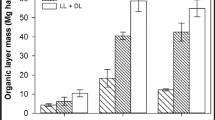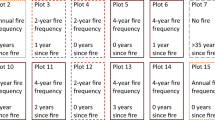Abstract
This study describes the results of the application of a single dormant season prescribed fire to two southern Ohio forest sites for the purposes of restoring the ecosystem functional properties that existed in these sites prior to major human intervention (clearcutting, fire suppression, and atmospheric deposition). Each forest site was composed of three contiguous watershed units, two of which were burned in April of 1996. The forest sites differed in soil pH and available litter mass prior to the fires, and in both sites pH and available inorganic N varied among landscape positions such that inorganic C increased with increasing longterm soil moisture potential (measured as the GIS-derived Integrated Moisture Index [IMI] developed for this region). The fire temperatures at 10 cm above the litter surface were generally 150–300 °C, and 29–80% of the litter was consumed, depending on site and landscape position. Soil solution total inorganic N (TIN) present one month after the fires did not differ significantly from that present prior to the fires in either burned or unburned watersheds, but was consistently greater in mesic landscape positions than in more xeric ones. N mineralization potential and organic C content varied both among fires and landscape positions. At the site which burned at higher intensity, soil N mineralization and TIN were both decreased by fire. At the less intensely burned site, fire resulted in increased TIN in the soils from the more xeric landscape position, and greater soil organic C in soils from the intermediate soil moisture areas. Path analysis produced models for fire-induced changes in C and N dynamics capable of explaining 26–69% of the observed variation using combinations of landscape and fire behavior. Losses of N to volatilization from these single fires were generally < 1 kg N/ha, and thus could not be expected to ameliorate the effects of atmospheric N deposition in these sites.
Similar content being viewed by others
References
Allison, L.E. 1965. Organic carbon. pp. 1367–1378. In Methods of Soil Analysis, Part 2, Chemical and Microbiological Properties Edited by C.A. Black, D.D. Evans, J.L. White, L.E. Ensminger and F.E. Clark. American Society for Agronomy, Madison, WI.
Arbuckle, J.L. 1995. Amos Users' Guide. SmallWaters Corporation, Chicago, IL.
Barnes, T.A. and Van Lear, D.H. 1998. Prescribed fire effects on advanced regeneration in mixed hardwood stands. Southern J Appl Forestry 22 (3): 138–142.
Barrett, S.W., Arno, S.F. and Menakis, J.P. 1997. Fire episodes in the inland northwest (1540–1940) based on fire history data. USDA Forest Service General Technical Report INT-GTR-370, Ogden, UT.
Benning, T.L. and Seastedt, T.R. 1995. Landscape-level interactions between topoedaphic features and nitrogen limitation in tallgrass prairie. Landscape Ecol 10: 337–348.
Boerner, R.E.J. 1982. Fire and nutrient cycling in temperate ecosystems. BioScience 32: 187–192.
Boerner, R.E.J. 1983. Nutrient dynamics of vegetation and detritus following two intensities of fire in the New Jersey pine barrens. Oecologia 59: 129–134.
Boerner, R.E.J. 1984. Nutrient fluxes in litterfall and decomposition in four forests along a gradient of soil fertility in southern Ohio. Can. J Forest Res 14: 794–802.
Boerner, R.E.J., Lord, T.R. and Peterson, J.C. 1986. Prescribed burning in the oak-pine forests of the New Jersey Pine Barrens: Effects on growth and nutrient dynamics of two Quercus species. Am Midland Nat 120: 108–119.
Boerner, R.E.J., Morris, S.J. and Decker, K.L.M. 2000 Soil chemical and physical properties. In Restoring Mixed Oak Forests in Southern Ohio. Edited by E.K. Sutherland. USDA Forest Service General Technical Report, Radnor, PA.
Boerner R.E.J. and Sutherland, E.K. 2000. Physiography, geology, and soil classification. In Restoring Mixed Oak Forests in Southern Ohio. Edited by E.K. Sutherland. USDA Forest Service General Technical Report, Radnor, PA.
Brose, P.H. and Van Lear, D.H. 1998. Responses of hardwood advance regeneration to seasonal prescribed fires in oak-dominated shelterwood stands. Can. J Forest Res. 28: 331–339.
Burns, P.Y. 1952. Effect of fire on forest soils in the Pine Barren region of New Jersey. Yale Forestry Bulletin #50, New Haven, CT.
Cole, K.L., Klick, K.F. and Pavlovic, N.B. 1992. Fire temperature monitoring during experimental burns at Indiana Dunes National Lakeshore. Nat Areas J 12: 177–183.
Day, G.M. 1953. The Indian as an ecological factor in the northeastern forest.Ecology 34: 329–346.
DeBano, L.F., Eberlein, G.E., Dunn, D.H. 1979. Effects of burning on chaparral soils: I. Soil nitrogen. Soil Sci Soc Am J 43: 504–509.
Decker, K.L.M., Boerner, R.E.J. and Jeakins, S., 1999. Scaledependent patterns of soil enzyme activity in a forested landscape. Can J Forest Res 29: 232–241.
DeSelm, H.R., Clebsch, E.E.C. and Rennie, J.C. 1991. Effects of 27 years of prescribed burning on an oak forest and its soils in middle Tennessee. In Proceedings of the Sixth Biennial Southern Silvicultural Research Conference. Menphis State University, Menphis, TN, pp. 409–417.
Dolan, R.W. 1994. Effects of a prescribed burn on tree-and herb-layer vegetation in a post oak (Quercus stellata) dominated flatwoods. Proc Indiana Acad Sci 103 (1–2): 25–32.
Dudley, J.L. and Lajtha, K. 1993. The effects of prescribed burning on nutrient availability and primary production in sandplain grasslands. Am Midland Nat 130: 286–298.
Fonteyn, P.J., Stone, M.W., Yancy, M.A. and Baccus, J.T. 1984. Interspecific and intraspecific microhabitat temperature variations during a fire. Am. Midland Nat 112 (2): 246–50.
Fowells, H.A. and Stephenson, R.E. 1934. The effect of burning on forest soils. Soil Sci 34: 175–181.
Franklin, S.B., Robertson, P.A. and Fralish, J.S. 1997. Small-scale fire temperature patterns in upland Quercus communities. J Appl Ecol. 34: 613–630.
Grabner, K., Dwyer, J. and Cutter, B. 1997. Validation of behave fire behavior predictions in Oak Savannas using five fuel models. In 11th Central Hardwood Forest Conference. St. Paul, Minnesota 55108: USDA, Forest Service, North Central Forest Experiment Station, pp. 202–215.
Griffith, A.L. 1946. The effects of burning on the soil as a preliminary to artificial regeneration. Indian Forestry Bulletin 130.
Hardy, C.C. and Arno, S.F. editors. 1996. The use of fire in forest restoration. USDA Forest Service General Technical Report INTGTR-341. Ogden, UT.
Hayward, F. 1938. Soil temperatures during forest fires in the longleaf pine region. J Forestry 36: 478–491.
Hendershot, W.H., Lalande, H. and Duquette, M. 1993. Soil reaction and exchangeable acidity. pp. 141–145. In Methods of Soil Analysis, Part 2, Chemical and Microbiological Properties Edited by C.A. Black, D.D. Evans, J.L. White, L.E. Ensminger and F.E. Clark. American Society for Agronomy, Madison, WI.
Hutchins, R.B., Blevins, R.L., Hill, J.D. and White, E.H. 1976. Influence of soils and microclimate on vegetation of forested slopes in eastern Kentucky. Soil Sci 121: 234–241.
Iverson, L.R., Dale, M.E., Scott, C.T. and Prasad, A. 1997. A GIS derived integrated moisture index to predict forest composition and productivity of Ohio forests (U.S.A.) Landscape Ecol. 12: 331–348.
Iverson, L.R. and Prasad, A. 2000. A GIS-derived integrated moisture index in mixed-oak forests of southern Ohio. In Restoring Mixed Oak Forests in Southern Ohio. Edited by E.K. Sutherland USDA Forest Service General Technical Report, Radnor, PA. In press.
Jorgenson, J.R. and Wells, C.G. 1971. Apparent nitrogen fixation in soil influenced by prescribed burning. Soil Sci Soc Am Proc 35: 806–810.
Knoepp, J.D. and Swank, W.T. 1993. Site preparation burning to improve southern Appalachian pine-hardwood stands: Nitrogen responses in soil, soil water, and streams. Can. J. Forest Res. 23: 2263–2270.
Morris, S.J. and Boerner, R.E.J. 1998a. Landscape patterns of nitrogen mineralization and nitrification in southern Ohio hardwood forests. Landscape Ecol 13: 215–224.
Morris, S.J. and Boerner, R.E.J. 1998b.Interactive influences of soil chemistry and forest management upon soil microbial abundance and N mineralization in two hardwood forests. Forest Ecol Manag 103: 129–139.
Phillips, M.J. and Goh, K.M. 1985. Extractable soil nitrogen following clearcutting and burning in a beech forest. Soil Sci Soc Am J 49: 1563–1568.
Pietikainen, J. and Fritze, H. 1993. Microbial biomass and activity in the humus layer following burning: short term effects of two different fires. Can. J. Forest Res. 23: 1275–1285.
Raison, R.J. 1979. Modification of the soil environment by vegetation fires, with particular reference to nitrogen transformations: a review. Plant Soil 51: 73–108.
Riebold, R.J 1971. The early history of wildfires and prescribed burning. pp. 11–19 In Prescribed Burning Symposium Proceedings, Asheville, NC. Edited by USDA Forest Service. USDA Forest Service Southeastern Forest Experiment Station.
S.A.S. 1995. Statistical Analysis System User's Guide: Statistics (on line documentation) SAS Institute, Cary, NC.
Schimel, D., Stillwell, M.A. and Woodmansee, R.G., 1985. Biogeochemistry of C, N, and P in a soil catena of the shortgrass steppe. Ecology 66: 276–282.
Stout, W. 1933. The charcoal iron industry of the hanging rock iron district: its influence on the development of the Ohio Valley. Ohio Archeology and History Quarterly 42: 72–104.
Sutherland, E.K. 1997. The history of fire in a southern Ohio second-growth mixed-oak forest. pp. 172–183. In Proceedings of the 11th Central Hardwood Forest Conferrence. Edited by S.G. Pallardy, R.A. Cecick, H.E. Garrett and P.S. Johnson USDA Forest Service North Central Forest Experiment Station, Minneapolis, MN.
Sutherland, E.K., editor. 2000. Restoring Mixed Oak Forests in Southern Ohio. USDA Forest Service General Technical Report, Radnor, PA. In press.
Sutherland, E.K. and Yaussy, D.A. 2000. Climate and fire weather in mixed-oak forests of southern Ohio. In Restoring Mixed Oak Forests in Southern Ohio. Edited by E.K. Sutherland. USDA Forest Service General Technical Report, Radnor, PA. In press.
Turner, M.G. and Romme, W.H. 1994. Landscape dynamics in crown fire ecosystems. Landscape Ecol 9: 59–77.
Vance, E.D. and Henderson, G.S. 1984. Soil nitrogen availability following long-term burning in an oak-hickory forest. Soil Sci Soc Am J 48: 184–190.
Vogt, K.A., Publicover, D.A. and Vogt, D.J. 1991. A critique of the role of ectomycorrhizae in forest ecology. Agric Ecosyst Environ 35: 171–190.
Wagle, R.F. and Kitchen, J.H. 1972. Influence of fire on soil nutrients in a ponderosa pine type. Ecology 53: 118–125.
Webb, B.G., Messina, M.G. and Guldin, J.M. 1991. Effects of prescribed burning and varying basal areas on nitrogen mineralization in an east Texas pine forest. In Proceedings of the Sixth Biennial Southern Silvicultural Research Conference. Memphis State University, Memphis, TN, pp. 418–430.
Wells, C.G. 1971. Effects of prescribed burning on soil chemical properties and nutrient availability. pp. 86–96. In Prescribed Burning Symposium Proceedings. Edited by USDA Forest Service. USDA Forest Service Southeastern Forest Experiment Station, Asheville, NC.
Whitney, G.G. 1994. From Coastal Wilderness to Fruited Plain: A History of Environmental Change in Temperate North America. Cambrige University Press, Cambridge.
Williams, M. 1989. Americans and Their Forest. Cambridge University Press, Cambridge.
Wolfe, J.N., Wareham, R.T. and Scofield, H.T. 1949. Microclimates and macroclimate of Neotoma: a small valley in central Ohio. Ohio Biol Survey Bull 41: 1–169.
Author information
Authors and Affiliations
Rights and permissions
About this article
Cite this article
Boerner, R.E., Morris, S.J., Sutherland, E.K. et al. Spatial variability in soil nitrogen dynamics after prescribed burning in Ohio mixed-oak forests. Landscape Ecology 15, 425–439 (2000). https://doi.org/10.1023/A:1008179702536
Issue Date:
DOI: https://doi.org/10.1023/A:1008179702536




